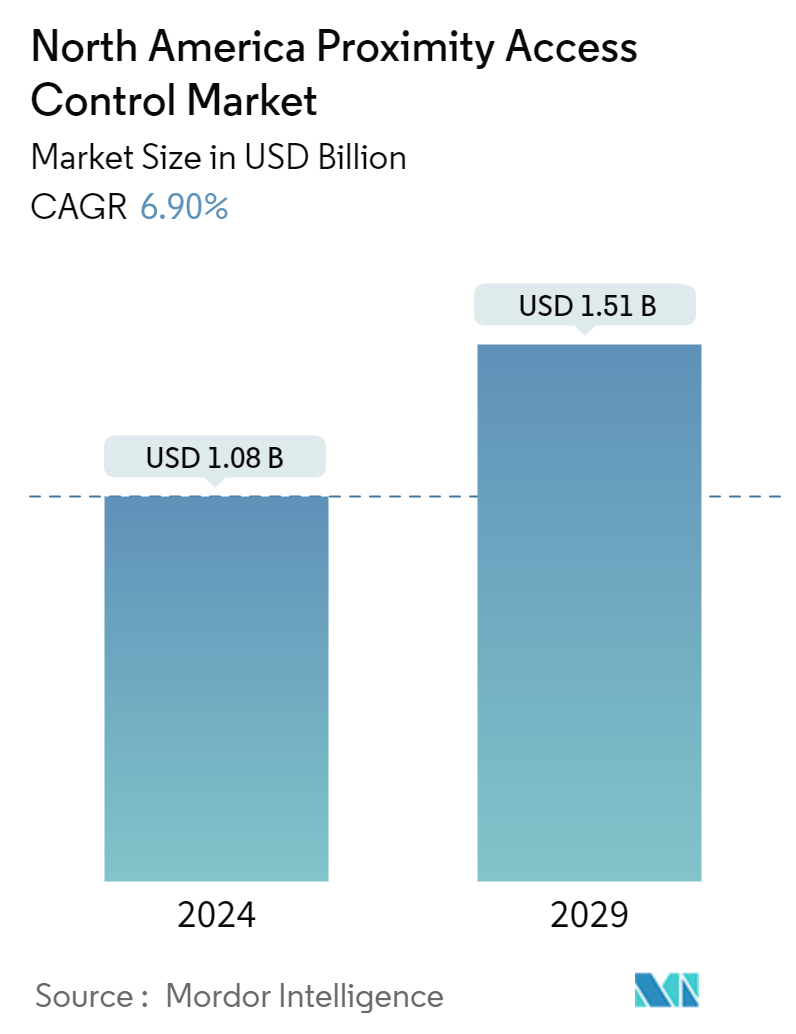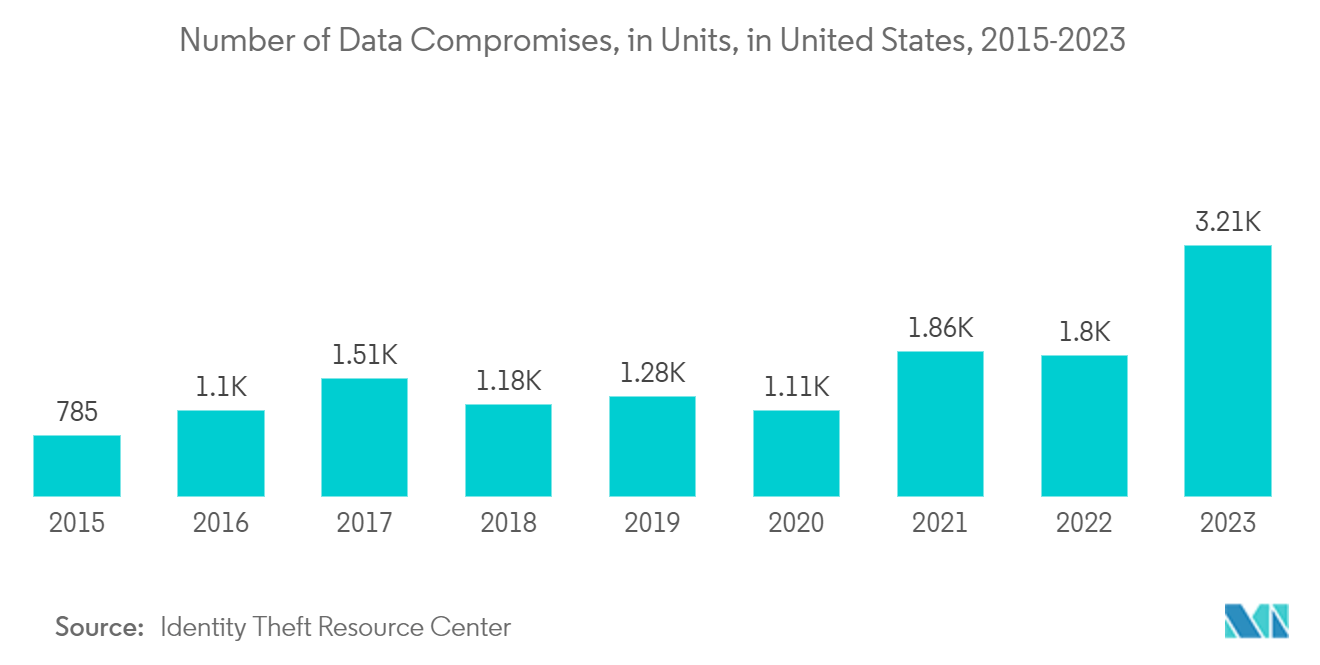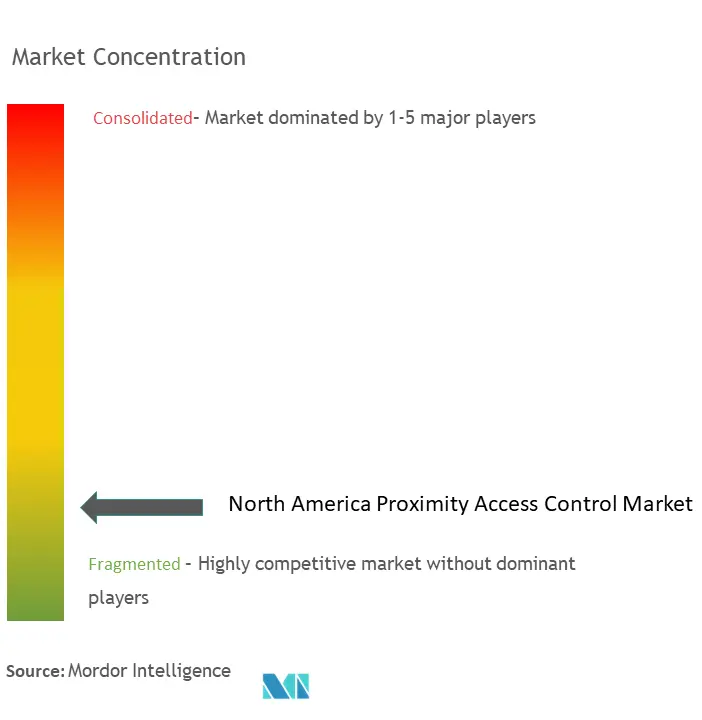North America Proximity Access Control Market Size

| Study Period | 2022 - 2029 |
| Base Year For Estimation | 2023 |
| Market Size (2024) | USD 1.08 Billion |
| Market Size (2029) | USD 1.51 Billion |
| CAGR (2024 - 2029) | 6.90 % |
| Market Concentration | Low |
Major Players
*Disclaimer: Major Players sorted in no particular order |
North America Proximity Access Control Market Analysis
The North America Proximity Access Control Market size is estimated at USD 1.08 billion in 2024, and is expected to reach USD 1.51 billion by 2029, growing at a CAGR of 6.90% during the forecast period (2024-2029).
- The utilization of access control systems for companies of all sizes has increased over recent years, driven by physical and cybersecurity threats. This increase is attributed to various factors, including increased criminal activity, technological progress in security systems and all aspects of business technology, and a rising trend toward cloud-based security solutions.
- Organizations have become increasingly focused on cybersecurity and digital intelligence, with particular emphasis on IT departments, and these elements are beginning to influence business buyers' decisions. As a result, digitized security systems are becoming the norm. Companies are beginning to recognize the numerous benefits digitized plans offer employees, ranging from increased productivity to the convenience of smartphone-based access. This shift toward more smart digital workplaces has just begun and is expected to continue for an extended period.
- For instance, in June 2023, Hanwha Vision America announced that the company had integrated the VMS (Wisenet WAVE) with Symmetry Technology's Access Control software. This integration was achieved by implementing the AMAG Integration Plugin, which facilitates the transfer of video cameras registered in the VMS to mapped sources within Symmetry software, such as access card readers, which can then be accessed in Symmetry's interface.
- Managed access control systems remain one of the primary components of physical security across most modern organizations, driving the market's growth. One of the primary advantages of hosting commercial security systems in a cloud-based environment is that businesses can have more control over the live installation of these systems.
- For instance, teams must access management platforms through the site's local network to effectively manage access controls and user authentication within a traditional, on-site system. This step indicates that the adjustment of functions such as active permissions, data security software, and access control door latches can only be done by teams from security and IT.
- Biometric scanners are integrated into Access Control systems to assess the appropriateness of an individual's access to a given facility or system. This biometric information is then cross-referenced with templates stored in a database to verify identity. For instance, as of August 2023, X's revised privacy policy will authorize the collection of biometric data from specific users. X will allow the user to present their government ID in conjunction with a selfie to add a layer of verification. Additionally, biometric data can be extracted from the ID and the selfie for matching purposes, which is intended to assist X in combating impersonation and enhancing the platform's security.
- Changing work patterns, such as the prevalence of remote work, may decrease the demand for physical access management systems in specific industries or enterprises. Major security incidents, such as breaches, can sometimes also result in heightened security awareness and investment in security systems.
- Regulatory and compliance developments in the region may also affect the need for access control solutions, either by necessitating a more robust system or by lowering the requirements. However, these events can also lead to temporary market instability, thus impeding the development of the market.
North America Proximity Access Control Market Trends
Card-based Systems are Expected to Hold a Significant Market Share during the Forecast Period
- Card-based systems account for significant market share and are typically operated with a scanner that verifies the barcode or chip of the user's card. Card-based systems are popular among buyers due to their versatility in various industries, as they can be integrated with computer systems, door systems, ATM systems, and safes.
- The growth of card-based systems has been accelerated by the need to modernize access systems and recognize the convenience and speed of card entry over keypad entry. According to Identity Theft Resource Center, in 2023, the United States recorded 3,205 data compromise incidents. In that same year, data breaches, leaks, and exposures collectively impacted over 353 million individuals.
- The access control industry is witnessing a dramatic increase in product technological innovation and revenue. The development is mainly attributed to the increasing demand for online digital solutions among B2B buyers.
- Access control technology is expected to advance significantly soon, particularly as the use of intelligent technology increases in both the residential and commercial sectors. These factors are because daily life is increasingly reliant on automated technology, making the access control industry a highly crucial market to enter. A prime example is the new credit card reader with cameras, which was introduced at Wal-Mart stores in Walt Disney World in the United States in August 2023. This card reader has a tap-to-pay touchpoint along its top, enabling customers to complete transactions using their magic bands, mobile devices, or tapped-enabled cards.
- Card readers can be connected to various transportation systems, including automated fare collection and ticketing applications. This integration facilitates the entire transportation system, making it more efficient and interconnected. As of March 2023, commuters in the Montreal-area transit system can charge their OPUS cards through a smartphone, provided the ARTM progresses with a planned project. Currently, OPUS cards can be reloaded at subway stations, at various points of sale, and online using a computer and an OPUS card reader.
- Organizations are investing in card readers to optimize operations and enhance the customer experience. For instance, in December 2023, Barcodes Group broadened its range of environmentally friendly, sustainable products by introducing EcoPass Access Cards. Crafted from 85% pre-consumer recycled plastic and featuring a PVC laminate overlay, EcoPass cards provide the same level of durability and printing quality as traditional PVC technology cards, all the while decreasing the use of single-use plastic with each card produced.

The United States is Expected to Witness Significant Growth during the Forecast Period
- Access control technology has seen a significant transformation over recent years. The country's urban regions have made remarkable strides in developing security systems, governmental buildings, IT centers, and commercial premises. Due to increased crime in urban areas, several commercial premises, including IT companies, businesses, and data centers, are implementing access control systems to safeguard personnel, prevent data breaches, and record employee entry and exit times.
- Implementing access control solutions, such as biometric scanners, facial recognition, iris recognition, and fingerprint recognition, offers a heightened level of security due to the verification of an individual's unique biological characteristics. These features eliminate the possibility of unauthorized individuals obtaining access through stolen credit cards or passwords, thus reducing the risk of unauthorized access.
- As the use of access control solutions continues to grow, the government has also taken an interest in safeguarding its assets. Numerous governments in the United States have implemented temporal access control systems to specific commercial or public facilities and restricted access to the public at particular locations.
- Several governments and security firms must increase security features in their organizations by deploying biometric scanners due to increased cyber and malware assaults in metropolitan areas. As a result, this further fuels the expansion of the US proximity access control market.
- Due to the increasing prevalence of cyber and malware incidents in urban areas, governments and security firms increasingly require card-based RFID technologies to enhance the security of their businesses. This growth contributes to the area's overall expansion of access control market segments.
- In 2023, there were 3,205 instances of data compromises in the United States. A significant number of individuals, totaling over 353 million, were affected by these data compromises, which encompassed incidents such as data breaches, leakage, and exposure. Such factors are expected to bring more demand for access control systems.

North America Proximity Access Control Industry Overview
The North American proximity access control market is fragmented. This market is highly competitive and consists of several players. The companies in the market are continuously trying to increase their market presence by expanding their operations, introducing new products, forming strategic partnerships, mergers and acquisitions, and collaborations. Some of the major players include Verkada Inc., Innovatrics, Vicon, Johnson Controls, and i2 Security Solutions.
• In April 2024, Acre Security announced the Acre Access Control in conjunction with the Acre Smart Controller and the Acre Reader. The integrated ecosystem provides a wide range of flexibility and presents the quickest and most intuitive path to embracing cloud technology. Collectively, these solutions furnish a straightforward and resilient security resolution to cater to the changing requirements of any establishment.
• In March 2024, Allegion US announced Schlage XE360 Series Wireless Locks, an electronic lock collection tailored to meet the demands of the multifamily market. This new series represents the latest advancement in electronic lock technology by Schlage, offering a variety of sought-after options and features catered to multifamily properties. The locks are designed to seamlessly integrate into a wide range of common area openings, ensuring versatility and convenience for property managers and residents alike.
North America Proximity Access Control Market Leaders
-
Verkada Inc.
-
Innovatrics
-
Vicon
-
Johnson Controls
-
i2 Security Solutions
*Disclaimer: Major Players sorted in no particular order

North America Proximity Access Control Market News
- March 2024: Princeton Identity introduced a biometrics device designed for the North American market. This versatile EyeAllow scanner offers a range of applications, including access control, time and attendance management, and point-of-sale systems. With its multimodal capabilities, the device supports face and iris biometrics, as well as RFID cards, high-frequency smartcards, mobile credentials, on-card biometrics, and PIN codes.
- January 2024: ICT announced the expansion of its product range to encompass wireless locking solutions for both multifamily and commercial purposes. The Protege Wireless Locks offered by the company are available in cartridge mortise and motorized deadbolt designs, providing customers with a diverse selection. These locks also come with customizable reader covers, rose, and handle options, allowing users to personalize their locking systems according to their preferences. The locks are also available in various finishes, further enhancing their versatility and suitability for different applications.
North America Proximity Access Control Market Report - Table of Contents
1. INTRODUCTION
- 1.1 Study Assumptions and Market Definition
- 1.2 Scope of the Study
2. RESEARCH METHODOLOGY
3. EXECUTIVE SUMMARY
4. MARKET INSIGHTS
- 4.1 Market Overview
-
4.2 Industry Attractiveness - Porter's Five Forces Analysis
- 4.2.1 Bargaining Power of Suppliers
- 4.2.2 Bargaining Power of Consumers
- 4.2.3 Threat of New Entrants
- 4.2.4 Threat of Substitutes
- 4.2.5 Intensity of Competitive Rivalry
- 4.3 Impact of COVID-19 Aftereffects and Other Macroeconomic Trends on the Market
5. MARKET DYNAMICS
-
5.1 Market Drivers
- 5.1.1 Integration of IoT and Cloud Technology
- 5.1.2 Continued Emphasis on Health and Safety
- 5.1.3 Increasing Emphasis on Touchless Access
-
5.2 Market Challenges
- 5.2.1 Increasing Security Concerns across Public and Private Sectors
- 5.2.2 Reduced Spending on Security and Technology Infrastructure due to Economic Downturns and Recessions
6. MARKET SEGMENTATION
-
6.1 By Solution
- 6.1.1 Hardware
- 6.1.2 Software
-
6.2 By Type
- 6.2.1 Card Readers
- 6.2.2 Biometric Scanners
- 6.2.3 Proximity Readers
- 6.2.4 Alarms
- 6.2.5 Metal Detectors
- 6.2.6 Door Controllers
- 6.2.7 Wireless Locks
-
6.3 By End-user Industry
- 6.3.1 Government Services
- 6.3.2 Banking and Financial Services
- 6.3.3 IT and Telecommunications
- 6.3.4 Transportation and Logistics
- 6.3.5 Retail
- 6.3.6 Healthcare
- 6.3.7 Residential
- 6.3.8 Other End-user Industries
-
6.4 By Country
- 6.4.1 United States
- 6.4.2 Canada
7. COMPETITIVE LANDSCAPE
-
7.1 Company Profiles*
- 7.1.1 Verkada Inc.
- 7.1.2 Innovatrics
- 7.1.3 Vicon
- 7.1.4 Johnson Controls
- 7.1.5 i2 Security Solutions
- 7.1.6 Securakey
- 7.1.7 Avigilon (Motorola Solutions Inc.)
- 7.1.8 HID Global
- 7.1.9 Honeywell International Inc
- 7.1.10 Schneider Electric
- 7.1.11 SALTO Systems
- 7.1.12 ADT
- 7.1.13 Idemia
- 7.1.14 Genetec
- 7.1.15 FaceKey
- 7.1.16 Dahua Technology Co. Ltd
8. INVESTMENT ANALYSIS
9. FUTURE OF THE MARKET
** Subject To AvailablityNorth America Proximity Access Control Industry Segmentation
The study tracks the revenue accrued through the sale of proximity access control hardware and software products by various players in North America. The study also tracks the key market parameters, underlying growth influencers, and major vendors operating in the industry, which supports the market estimations and growth rates over the forecast period. The study further analyses the overall impact of COVID-19 aftereffects and other macroeconomic factors on the market. The report's scope encompasses market sizing and forecasts for the various market segments.
The North American proximity access control market is segmented by solution (hardware and software), type (card readers, biometric scanners, proximity readers, alarms, metal detectors, door controllers, and wireless locks), end-user industry (government services, banking and financial services, it and telecommunications, transportation and logistics, retail, healthcare, residential, and other end-user industries), and country (United States and Canada). The market sizes and forecasts are provided in terms of value (USD) for all the above segments.
| By Solution | Hardware |
| Software | |
| By Type | Card Readers |
| Biometric Scanners | |
| Proximity Readers | |
| Alarms | |
| Metal Detectors | |
| Door Controllers | |
| Wireless Locks | |
| By End-user Industry | Government Services |
| Banking and Financial Services | |
| IT and Telecommunications | |
| Transportation and Logistics | |
| Retail | |
| Healthcare | |
| Residential | |
| Other End-user Industries | |
| By Country | United States |
| Canada |
North America Proximity Access Control Market Research FAQs
How big is the North America Proximity Access Control Market?
The North America Proximity Access Control Market size is expected to reach USD 1.08 billion in 2024 and grow at a CAGR of 6.90% to reach USD 1.51 billion by 2029.
What is the current North America Proximity Access Control Market size?
In 2024, the North America Proximity Access Control Market size is expected to reach USD 1.08 billion.
Who are the key players in North America Proximity Access Control Market?
Verkada Inc., Innovatrics, Vicon, Johnson Controls and i2 Security Solutions are the major companies operating in the North America Proximity Access Control Market.
What years does this North America Proximity Access Control Market cover, and what was the market size in 2023?
In 2023, the North America Proximity Access Control Market size was estimated at USD 1.01 billion. The report covers the North America Proximity Access Control Market historical market size for years: 2022 and 2023. The report also forecasts the North America Proximity Access Control Market size for years: 2024, 2025, 2026, 2027, 2028 and 2029.
North America Proximity Access Control Industry Report
Statistics for the 2024 North America Proximity Access Control market share, size and revenue growth rate, created by Mordor Intelligence™ Industry Reports. North America Proximity Access Control analysis includes a market forecast outlook for 2024 to 2029 and historical overview. Get a sample of this industry analysis as a free report PDF download.



